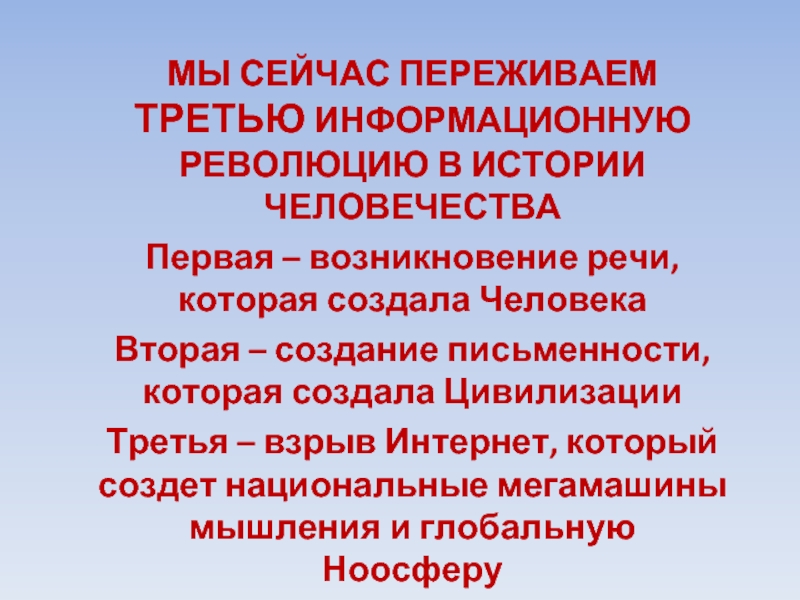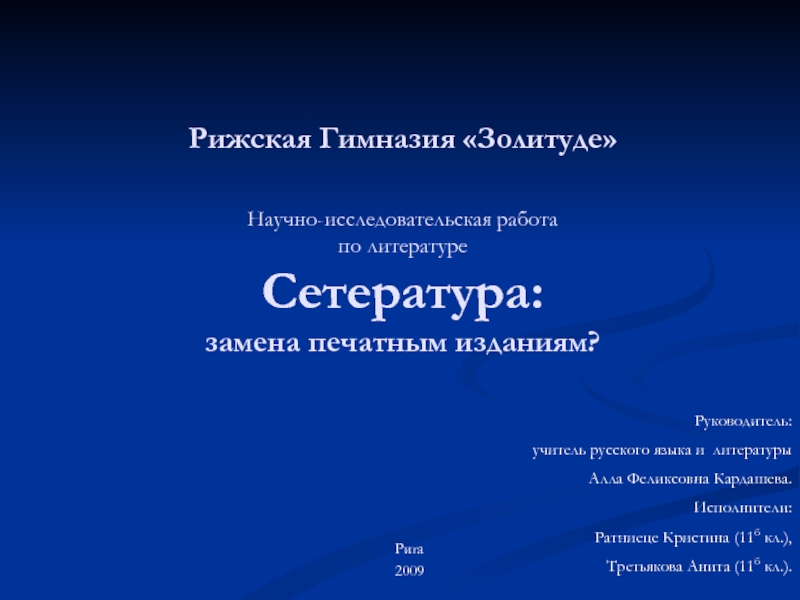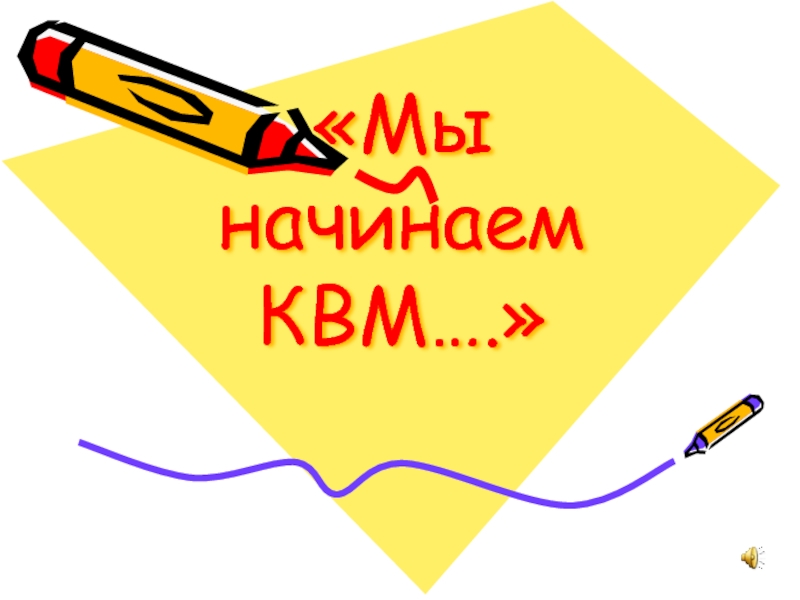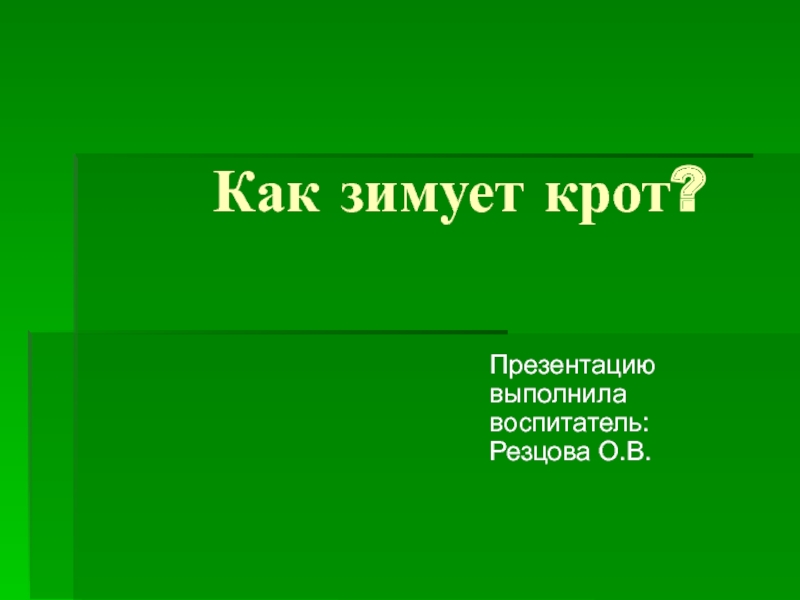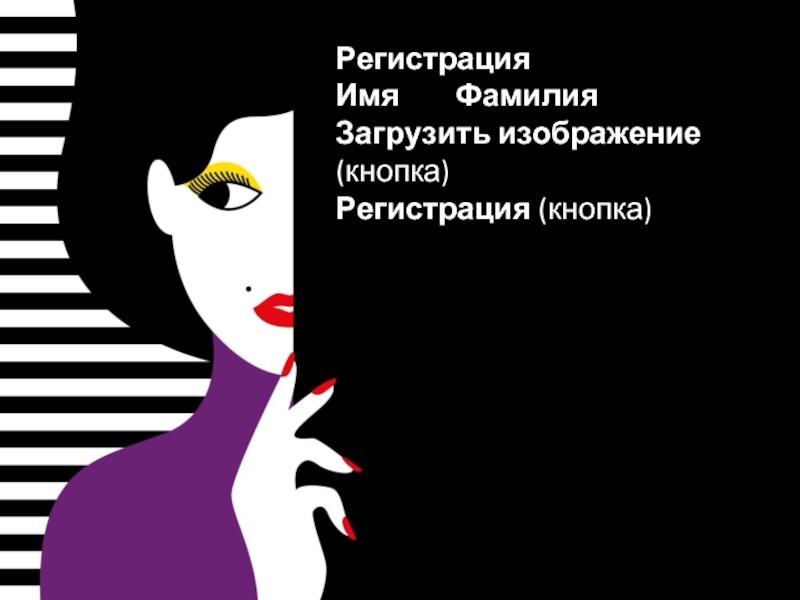- Главная
- Разное
- Дизайн
- Бизнес и предпринимательство
- Аналитика
- Образование
- Развлечения
- Красота и здоровье
- Финансы
- Государство
- Путешествия
- Спорт
- Недвижимость
- Армия
- Графика
- Культурология
- Еда и кулинария
- Лингвистика
- Английский язык
- Астрономия
- Алгебра
- Биология
- География
- Детские презентации
- Информатика
- История
- Литература
- Маркетинг
- Математика
- Медицина
- Менеджмент
- Музыка
- МХК
- Немецкий язык
- ОБЖ
- Обществознание
- Окружающий мир
- Педагогика
- Русский язык
- Технология
- Физика
- Философия
- Химия
- Шаблоны, картинки для презентаций
- Экология
- Экономика
- Юриспруденция
Remotely Controlling Devices презентация
Содержание
- 1. Remotely Controlling Devices
- 2. Remotely Controlling Devices interact with almost any
- 3. IR remote works by turning an LED
- 4. IR remote low-cost IR receiver module detect
- 5. Wireless radio technology more difficult to emulate
- 6. Optocouplers Components called optocouplers are used to
- 7. Responding to an IR Control Arduino responds
- 8. Responding to an IR Control #include //adds
- 9. IRremote library #include - makes the library
- 10. IRremote library irrecv.enableIRIn(); - start listening the
- 11. Decoding IR Control Signals #include const
- 12. Imitating Remote Control Signals want to use
- 13. Imitating Remote Control Signals irsend.sendSony(code, nob); -
- 14. Imitating Remote Control Signals LED is connected
- 15. Imitating Remote Control Signals #include const
- 16. Liquid crystal displays (LCD) offer a convenient
- 17. LCD vs. Graphical Display create your own
- 18. Connecting and Using a Text LCD Display
- 19. Connecting and Using a Text LCD Display
- 20. LCD library functions LiquidCrystal(rs, enable, d4, d5,
- 21. LCD library functions lcd.setCursor(col, row) - set
- 22. Formatting Text #include // include the library
- 23. Turning the Cursor and Display On or
- 24. Displaying Special Symbols #include const int
- 25. Character codes
- 26. Character codes
- 27. Creating Custom Characters #include LiquidCrystal lcd(12,
Слайд 2Remotely Controlling Devices
interact with almost any device that uses some form
TVs, audio equipment, cameras, garage doors, appliances, and toys
remote controls work by sending digital data from a transmitter to a receiver
infrared light (IR) or wireless radio technology
different protocols (signal patterns) used
translate key presses into a digital signal
Слайд 3IR remote
works by turning an LED on and off in patterns
produce
codes are typically 12 to 32 bits
Each key on the remote is associated with a specific code that is transmitted when the key is pressed
If the key is held down, the remote usually sends the same code repeatedly
some remotes (e.g.,NEC) send a special repeat code when a key is held down
Слайд 4IR remote
low-cost IR receiver module
detect the signal and provide a digital
digital output is then decoded by a library called IRremote
same library is used when Arduino sends commands to act like a remote control
to install the library, place it in the folder named libraries in your Arduino sketch folder
Слайд 5Wireless radio technology
more difficult to emulate than IR controls
button contacts on
simulate button presses by closing the button contacts circuit inside the remote control
need to take apart the remote control and connect wires from the contacts to Arduino
isolation prevents voltages from Arduino from harming the remote control, and vice versa
Слайд 6Optocouplers
Components called optocouplers are used to provide electrical separation between Arduino
enable you to safely control another circuit
provide a way to keep things electrically separated
contain an LED, which can be controlled by an Arduino digital pin
light from the LED in the optocoupler shines onto a light-sensitive transistor
turning on the LED causes the transistor to conduct
Слайд 7Responding to an IR Control
Arduino responds to IR remote signals using
The IR receiver converts the IR signal to digital pulses
IR remote library decodes these pulses and provides a numeric value for each key
Слайд 8Responding to an IR Control
#include //adds the library code to
const int irReceiverPin = 2; //pin the receiver is connected to
const int ledPin = 13;
IRrecv irrecv(irReceiverPin); //create an IRrecv object
decode_results decodedSignal; //stores results from IR detector
boolean lightState = false; //keep track of whether the LED is on
unsigned long last = millis(); //remember when we last received an IR message
void setup(){
pinMode(ledPin, OUTPUT);
irrecv.enableIRIn(); // Start the receiver object
}
void loop(){
if (irrecv.decode(&decodedSignal) == true){ //true if message received
if (millis() - last > 250) { //has it been 1/4 sec since last message?
lightState = !lightState; //Yes: toggle the LED
digitalWrite(ledPin, lightState);
}
last = millis();
irrecv.resume(); // watch out for another message
}
}
Слайд 9IRremote library
#include - makes the library code available to your
IRrecv irrecv(irReceiverPin); - creates an IRrecv object to receive signals from an IR receiver module connected to irReceiverPin
use the irrecv object to access the signal from the IR receiver
decoded responses provided by the library are stored in a variable named decode_results
Слайд 10IRremote library
irrecv.enableIRIn(); - start listening the IR receiver
irrecv.decode(&decodedSignal); - check the
returns true if there is data, which will be placed in the decodedSignal
irrecv.resume(); - library needs to be told to continue monitoring for signals
code toggles the LED if more than ¼ s since the last received message (otherwise, the LED will toggle quickly by remotes that send codes more than once)
Слайд 11Decoding IR Control Signals
#include
const int RECV_PIN = 2;
const int NUM_OF_BUTS
long BUTTON_CODES[NUM_OF_BUTS] = {
0xE0E08877, //button 0
0xE0E020DF, //button 1
0xE0E0A05F, //button 2
0xE0E0609F, //button 3
0xE0E010EF, //button 4
0xE0E0906F, //button 5
0xE0E050AF, //button 6
0xE0E030CF, //button 7
0xE0E0B04F, //button 8
0xE0E0708F, //button 9
0xE0E08679, //button 100+/DOWN
0xE0E006F9, //button 200+/UP
0xE0E0D02F, //button VOL-
0xE0E0E01F, //button VOL+
0xE0E016E9, //button EQ/MENU
0xE0E0A659, //button PREV/LEFT
0xE0E046B9, //button NEXT/RIGHT
0xE0E0F00F, //button PAUSE/MUTE
0xE0E008F7, //button CH-
0xE0E048B7, //button CH+
0xE0E040BF //button CH/POWER
};
String BUTTON_NAMES[NUM_OF_BUTS] = {
"0","1","2","3","4","5","6","7","8","9",
"100+/DOWN","200+/UP","VOL-","VOL+",
"EQ/MENU","PREV/LEFT","NEXT/RIGTH",
"PAUSE/MUTE","CH-","CH+","CH/POWER"
};
IRrecv irrecv(RECV_PIN);
decode_results results;
void setup(){
Serial.begin(9600);
irrecv.enableIRIn(); // Start the receiver
}
void loop() {
if (irrecv.decode(&results)) {
//Serial.println(results.value, HEX);
int button_id = findButton(results.value);
if(button_id <0){
Serial.println("Unknown button is pressed!");
} else{
Serial.print("Button ");
Serial.print(BUTTON_NAMES[button_id]);
Serial.println(" is pressed!");
}
irrecv.resume(); // Receive the next value
}
}
int findButton(long val){
for(int i = 0; i < NUM_OF_BUTS; i++){
if(val == BUTTON_CODES[i]) return i;
}
return -1;
}
Слайд 12Imitating Remote Control Signals
want to use Arduino to control a TV
Arduino controls the device by flashing an IR LED
duplicate the signal that would be sent from your remote control
IR library handles the translation from numeric code to IR LED flashes
need to create an object for sending IR messages
IRsend object - control the IR LED on pin 3
hardcoded within the library, can not change it
Слайд 13Imitating Remote Control Signals
irsend.sendSony(code, nob); - send code in sony format
irSend object has different functions for various popular infrared code formats
check the library documentation for other formats
Each character in hex represents a 4-bit value
The codes here use eight characters, so they are 32 bits long
Слайд 14Imitating Remote Control Signals
LED is connected with a current-limiting resistor
to increase
you won’t see anything when the codes are sent because the light from the IR LED isn’t visible to the naked eye.
verify that an infrared LED is working with a digital camera
you should be able to see it flashing in the camera’s LCD viewfinder.
Слайд 15Imitating Remote Control Signals
#include
const int NUM_OF_BUTS = 21;
long BUTTON_CODES[NUM_OF_BUTS] =
0xE0E08877, //button 0
0xE0E020DF, //button 1
0xE0E0A05F, //button 2
0xE0E0609F, //button 3
0xE0E010EF, //button 4
0xE0E0906F, //button 5
0xE0E050AF, //button 6
0xE0E030CF, //button 7
0xE0E0B04F, //button 8
0xE0E0708F, //button 9
0xE0E08679, //button 100+/DOWN
0xE0E006F9, //button 200+/UP
0xE0E0D02F, //button VOL-
0xE0E0E01F, //button VOL+
0xE0E016E9, //button EQ/MENU
0xE0E0A659, //button PREV/LEFT
0xE0E046B9, //button NEXT/RIGHT
0xE0E0F00F, //button PAUSE/MUTE
0xE0E008F7, //button CH-
0xE0E048B7, //button CH+
0xE0E040BF //button CH/POWER
};
IRsend irsend;
void setup(){
}
void loop() {
for (int i = 0; i < NUM_OF_BUTS; i++) {
irsend.sendSony(BUTTON_CODES[i], 32);
delay(40);
//half second delay between each signal burst
}
}
Слайд 16Liquid crystal displays (LCD)
offer a convenient and inexpensive way to provide
is the text panel that displays two or four lines of text, with 16 or 20 characters per line
library for driving LCD is provided with Arduino
can do more than display simple text
can be scrolled or highlighted
can display special symbols and non-English characters
Слайд 17LCD vs. Graphical Display
create your own symbols and block graphics with
small resolution (5x9, 7x12, 8x16)
graphical LCD has fine graphical details
can display up to eight lines of 20 text characters in addition to graphics
Слайд 19Connecting and Using a Text LCD Display
#include // include the
//constants for the number of rows and columns in the LCD
const int numRows = 2;
const int numCols = 16;
// initialize the library with the numbers of the interface pins
LiquidCrystal lcd(12, 11, 5, 4, 3, 2); //RS, E, D4, D5, D6, D7
void setup(){
lcd.begin(numCols, numRows);
lcd.print("hello, world!"); // Print a message to the LCD.
}
void loop(){
// set the cursor to column 0, line 1
// (note: line 1 is the second row, since counting begins with 0):
lcd.setCursor(0, 1);
// print the number of seconds since reset:
lcd.print(millis()/1000);
}
If you don’t see any text and you have double-checked that all wires are connected correctly, you may need to adjust the contrast pot. With the pot shaft rotated to one side (usually the side connected to Gnd), you will have maximum contrast and should see blocks appear in all the character positions. With the pot rotated to the other extreme, you probably won’t see anything at all. The correct setting will depend on many factors, including viewing angle and temperature—turn the pot until you get the best looking display
Слайд 20LCD library functions
LiquidCrystal(rs, enable, d4, d5, d6, d7) - Creates a
lcd.begin(cols, rows) - Initializes the interface to the LCD screen, and specifies the dimensions (width and height) of the display
lcd.clear() - Clears the LCD screen and positions the cursor in the upper-left corner
lcd.home() - Positions the cursor in the upper-left of the LCD
Слайд 21LCD library functions
lcd.setCursor(col, row) - set the location (column and row)
lcd.write(data) - Write a custom character to the LCD
lcd.print(data) - Prints text to the LCD.
lcd.cursor() / lcd.noCursor() - Set cursor visible/invisible
lcd.blink() / lcd.noBlink() - Turns blinking of the cursor on/off
lcd.display() / lcd.noDisplay() - Turns on/off the LCD display
lcd.scrollDisplayLeft() / lcd.scrollDisplayRight() - Scrolls the contents of the display one space to the left/right
lcd.createChar(num, data) - Create a custom character specified by data. Up to eight characters of 5x8 pixels are supported (num - 0 to 7)
Слайд 22Formatting Text
#include // include the library code:
//constants for the number
const int numRows = 2;
const int numCols = 16;
int count;
// initialize the library with the numbers of the interface pins
LiquidCrystal lcd(12, 11, 5, 4, 3, 2);
void setup(){
lcd.begin(numCols, numRows);
lcd.print("Starting in "); // this string is 12 characters long
for(int i=9; i > 0; i--){ // count down from 9
// the top line is row 0
lcd.setCursor(12,0); // move the cursor to the end of the string
lcd.print(i);
delay(1000);
}
}
void loop(){
int columnWidth = 4; //spacing for the columns
int displayColumns = 3; //how many columns of numbers
lcd.clear();
for(int col=0; col < displayColumns; col++){
lcd.setCursor(col * columnWidth, 0);
count = count + 1;
lcd.print(count);
}
delay(1000);
}
Слайд 23Turning the Cursor and Display On or Off
#include
LiquidCrystal lcd(12, 11,
void setup(){
lcd.begin(16, 2);
lcd.print("hello, world!");
}
void displayBlink(int blinks, int duration){
while(blinks--){
lcd.noDisplay();
delay(duration);
lcd.display();
delay(duration);
}
}
void loop(){
lcd.setCursor(0, 1);
lcd.print("cursor blink");
lcd.blink();
lcd.setCursor(0, 1);
lcd.print("noBlink");
delay(2000);
lcd.noBlink();
delay(2000);
lcd.clear();
lcd.print("Display off ...");
delay(1000);
lcd.noDisplay();
delay(2000);
lcd.display();
// turn the display back on
lcd.setCursor(0, 0);
lcd.print(" display flash !");
displayBlink(2, 250);
// blink twice
displayBlink(2, 500);
// and again for twice as long
lcd.clear();
}
Слайд 24Displaying Special Symbols
#include
const int numRows = 2;
const int numCols =
const byte degreeSymbol = B11011111;
const byte piSymbol = B11110111;
const byte centsSymbol = B11101100;
const byte sqrtSymbol = B11101000;
const byte omegaSymbol = B11110100; // the symbol used for ohms
byte charCode = 32; // the first printable ascii character
int col; int row;
LiquidCrystal lcd(12, 11, 5, 4, 3, 2);
void setup(){
lcd.begin(numRows, numCols);
}
void loop(){
showSymbol(degreeSymbol, "degrees");
showSymbol (piSymbol, "pi");
showSymbol(centsSymbol, "cents");
showSymbol(sqrtSymbol, "sqrt");
showSymbol(omegaSymbol, "ohms");
}
void showSymbol( byte symbol, char * description){
lcd.clear();
lcd.write(symbol);
lcd.print(' '); // add a space before the description
lcd.print(description);
delay(3000);
}
Слайд 27Creating Custom Characters
#include
LiquidCrystal lcd(12, 11, 5, 4, 3, 2);
byte happy[8]
{
B00000,
B10001,
B00000,
B00000,
B10001,
B01110,
B00000,
B00000
};
byte saddy[8] =
{
B00000,
B10001,
B00000,
B00000,
B01110,
B10001,
B00000,
B00000
};
void setup() {
lcd.createChar(0, happy);
lcd.createChar(1, saddy);
lcd.begin(16, 2);
}
void loop() {
for (int i=0; i<2; i++){
lcd.setCursor(0,0);
lcd.write(i);
delay(500);
}
}
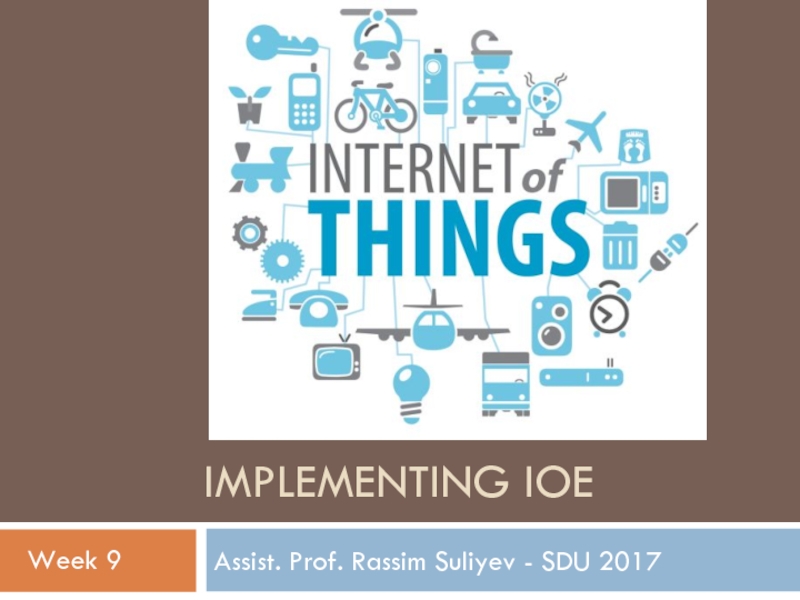
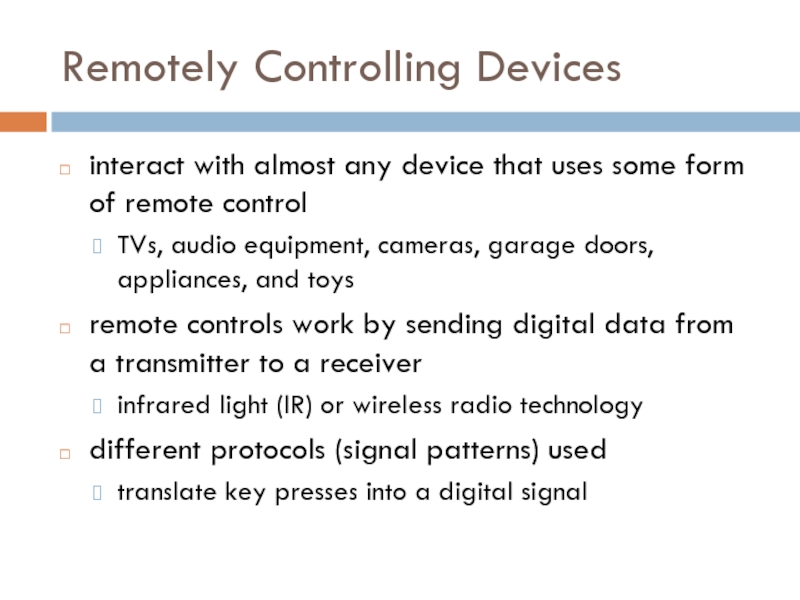
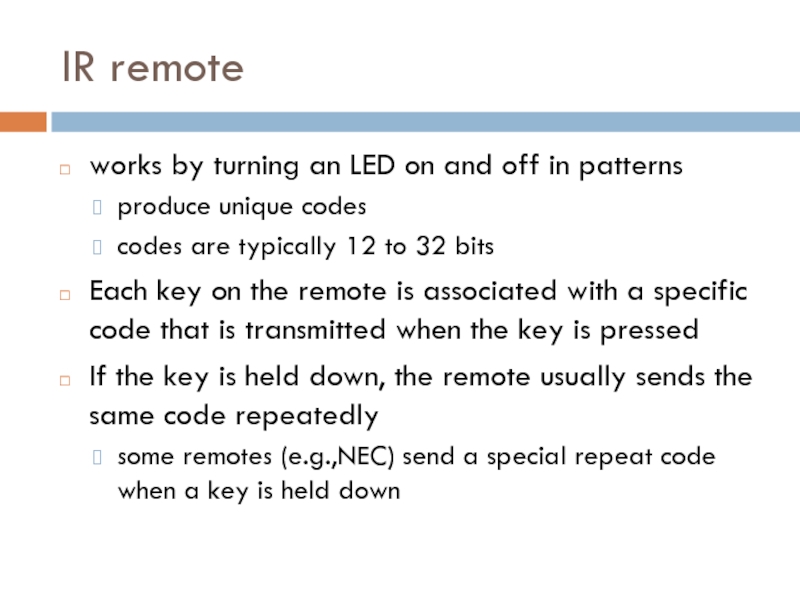


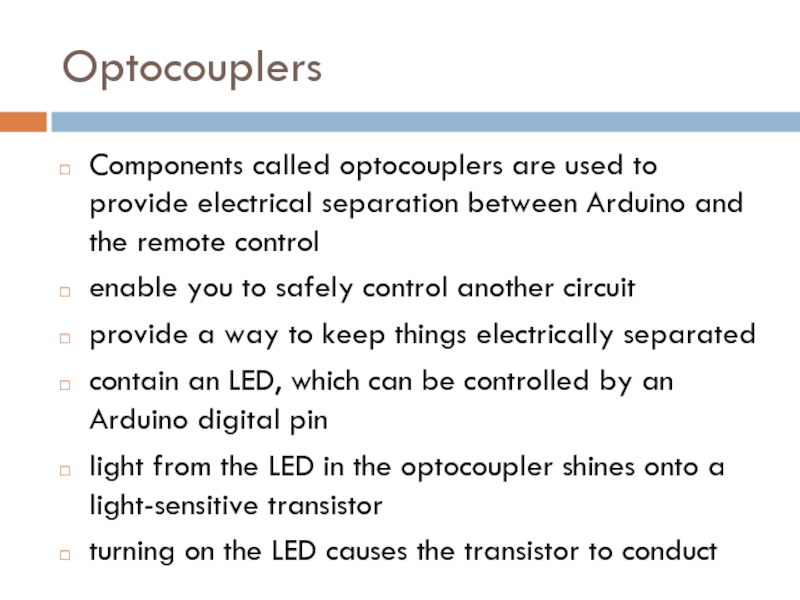
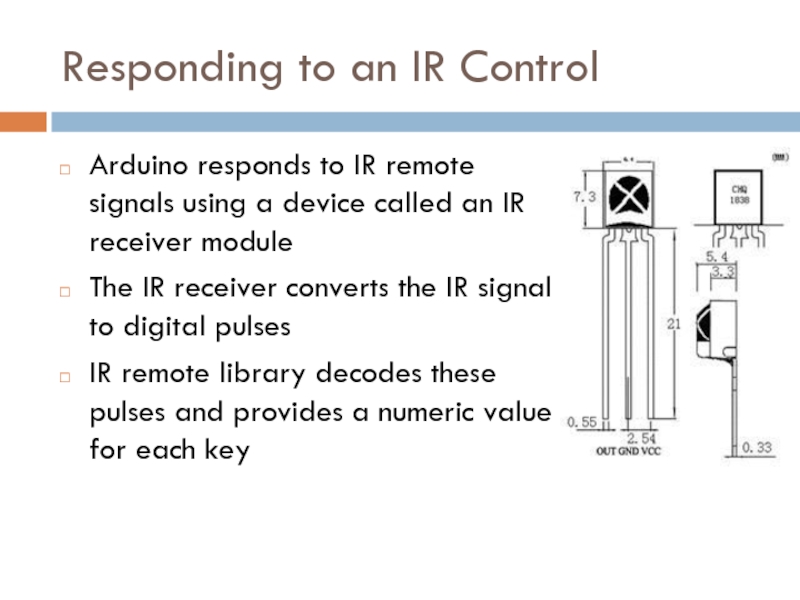
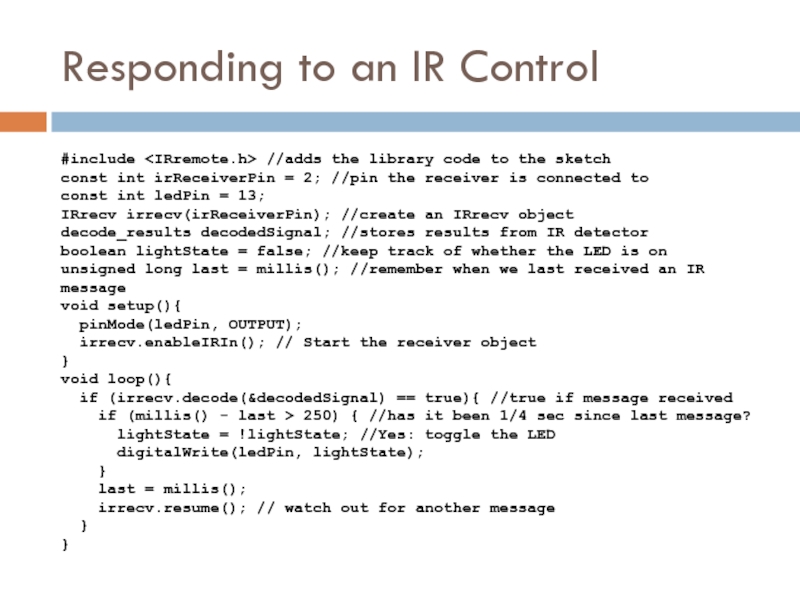
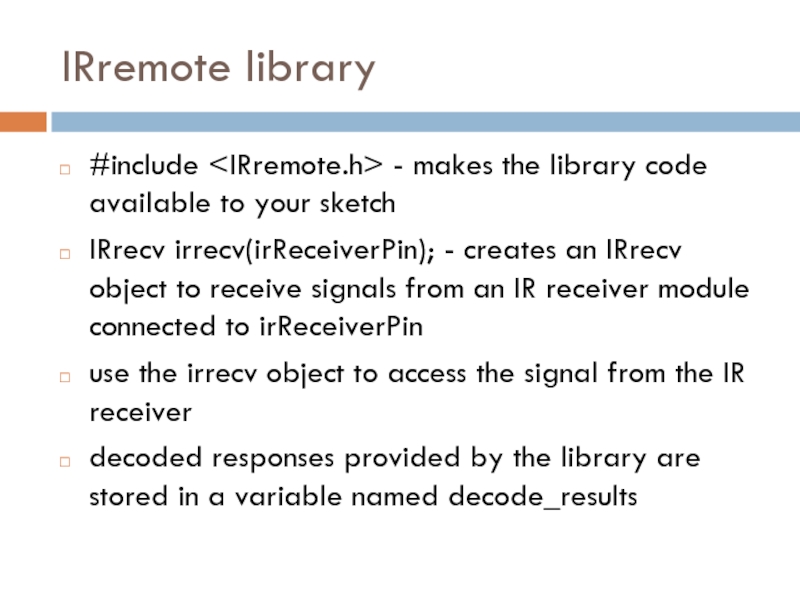
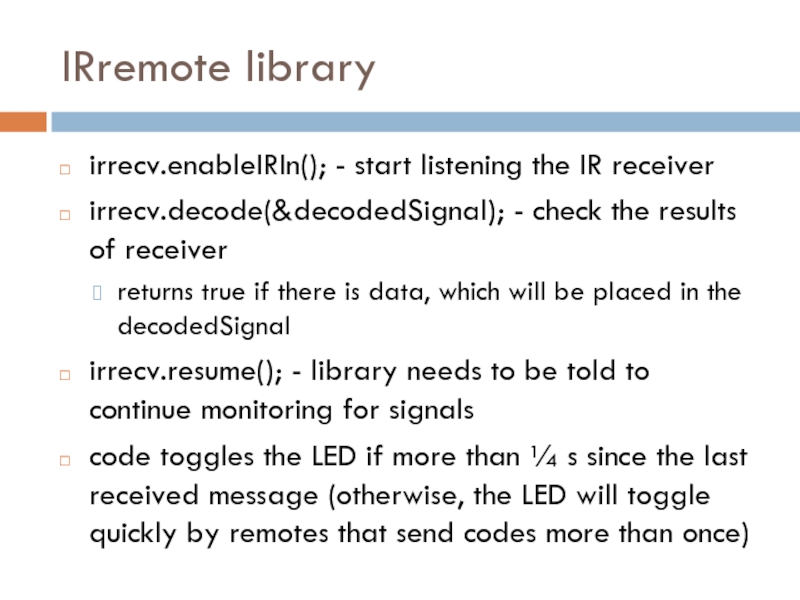
![Decoding IR Control Signals#include const int RECV_PIN = 2;const int NUM_OF_BUTS = 21;long BUTTON_CODES[NUM_OF_BUTS] =](/img/tmb/5/454223/b2cd17fa2d702579b01cdf59fd997d0b-800x.jpg)
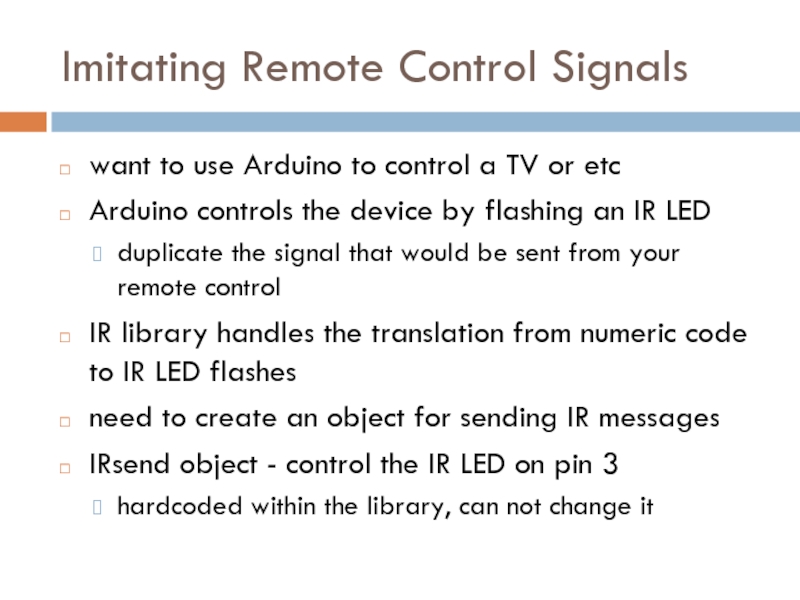
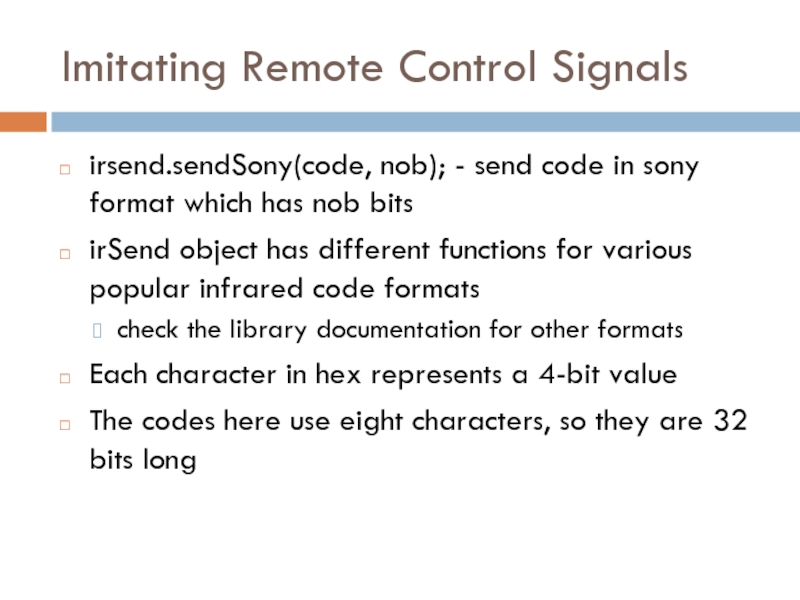
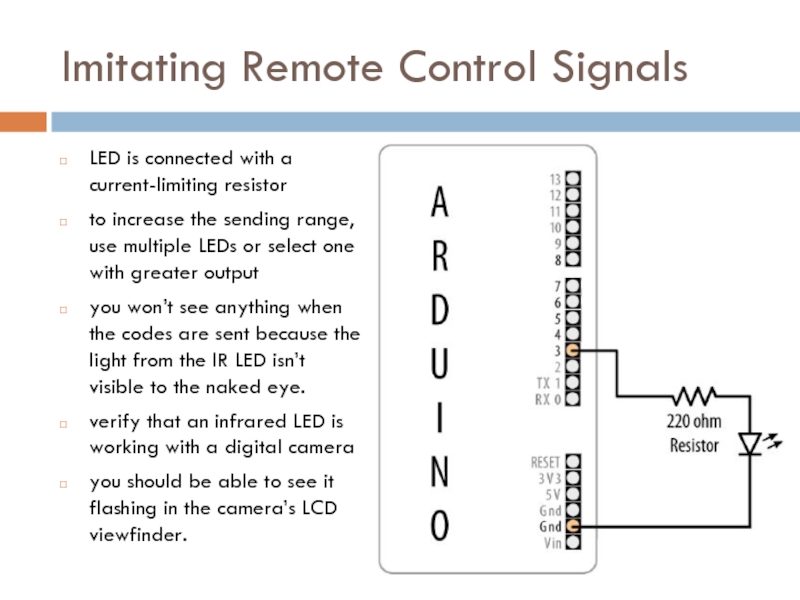
![Imitating Remote Control Signals#include const int NUM_OF_BUTS = 21;long BUTTON_CODES[NUM_OF_BUTS] = { 0xE0E08877, //button 0](/img/tmb/5/454223/68c6806d10605b5d9bcd84c71452319c-800x.jpg)
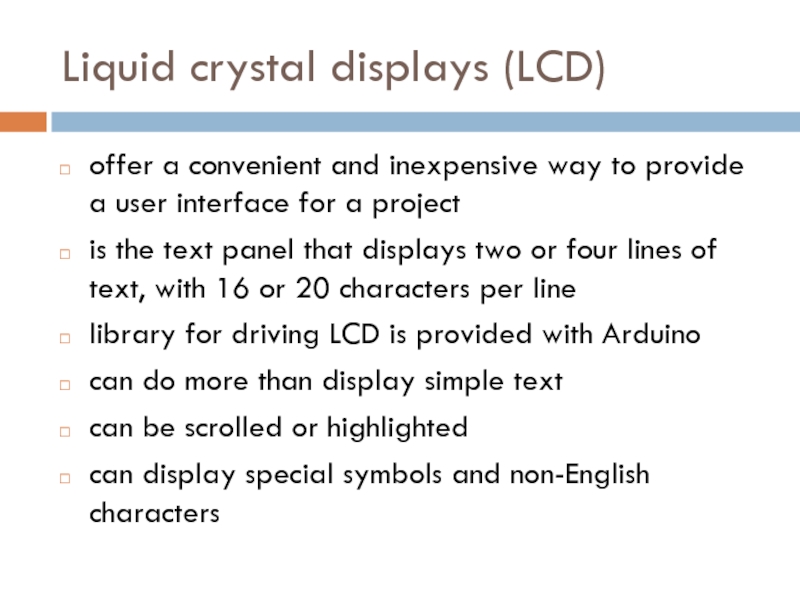
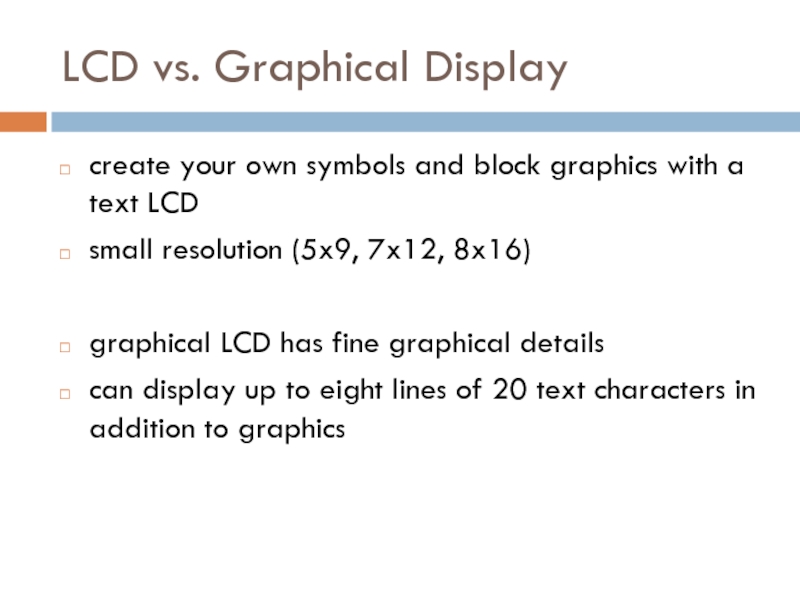

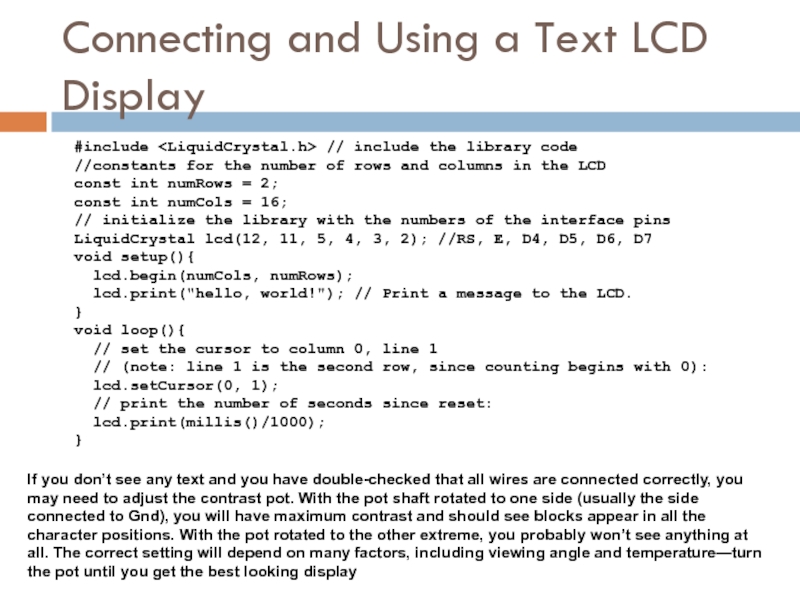
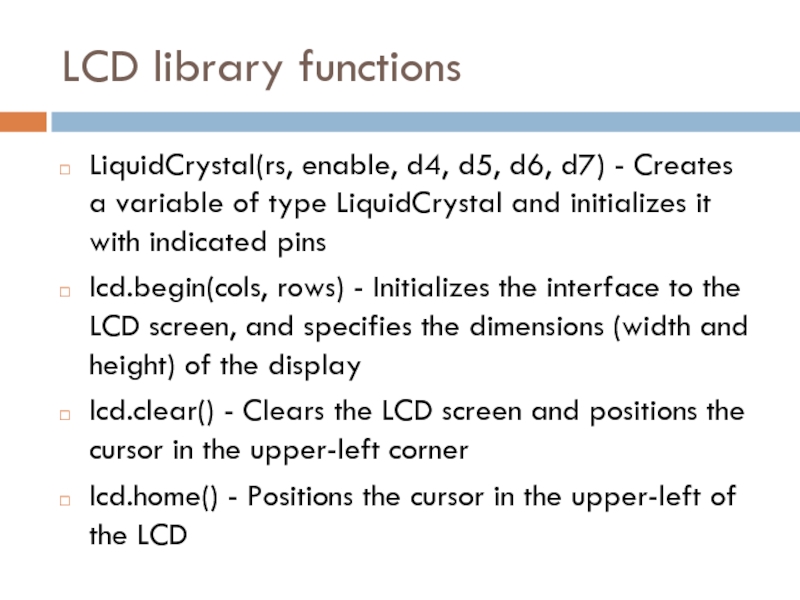
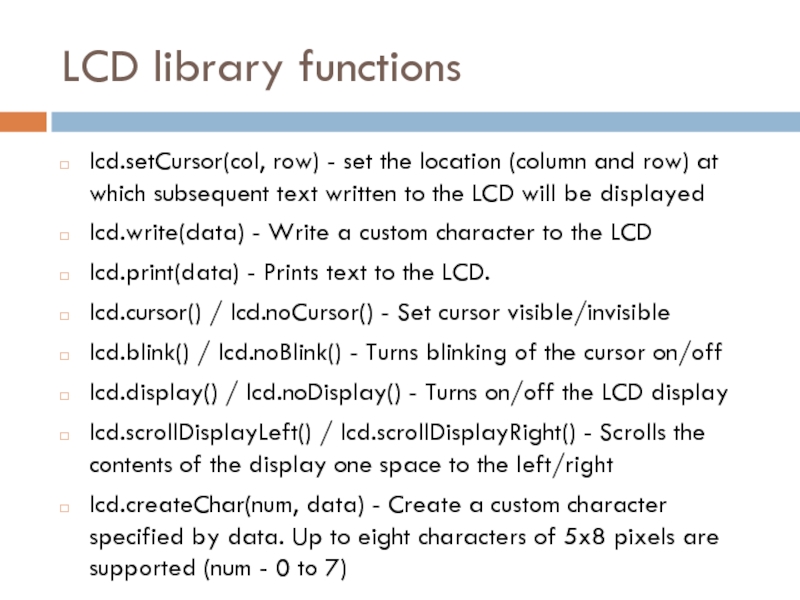
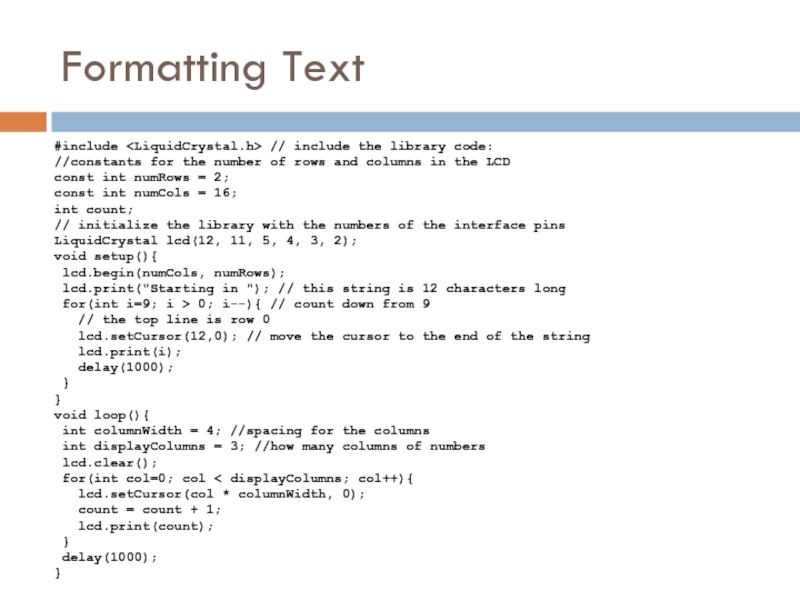
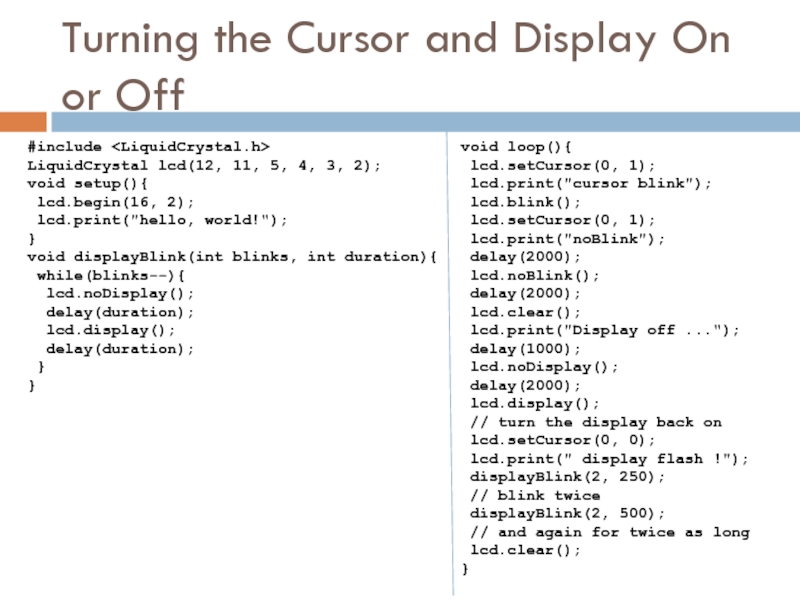
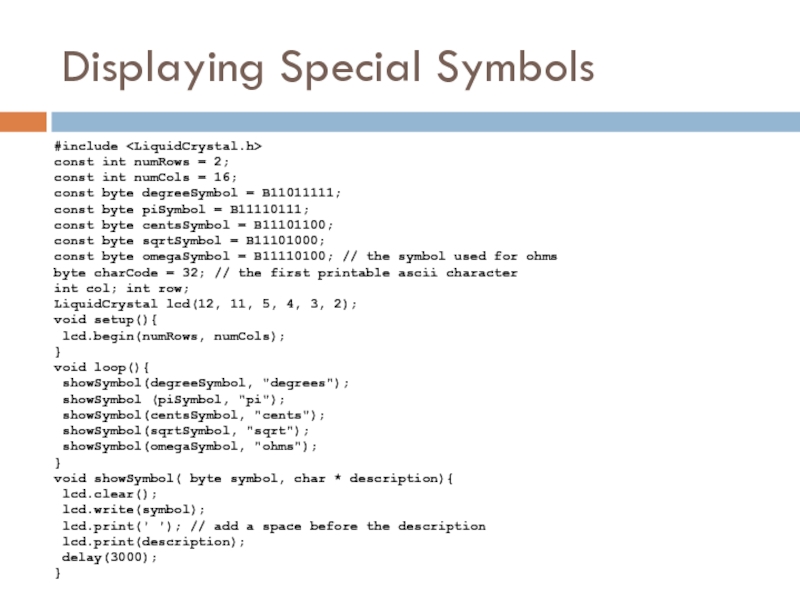
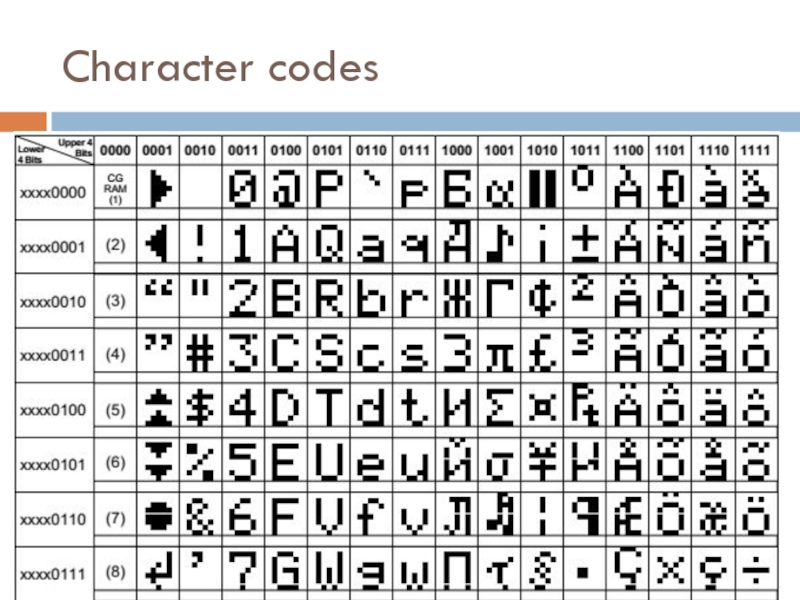
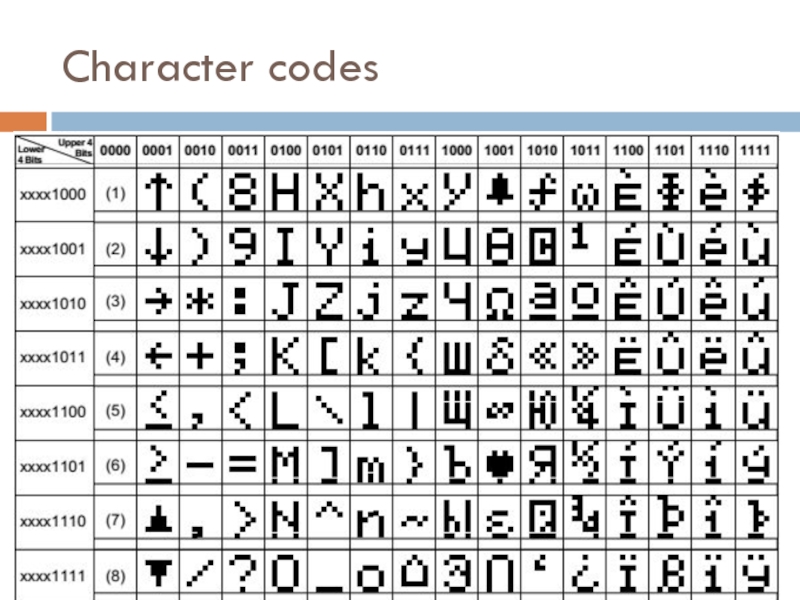
![Creating Custom Characters#include LiquidCrystal lcd(12, 11, 5, 4, 3, 2);byte happy[8] ={ B00000, B10001, B00000,](/img/tmb/5/454223/839a2130ef46ec248ffa01e5fb32b317-800x.jpg)
